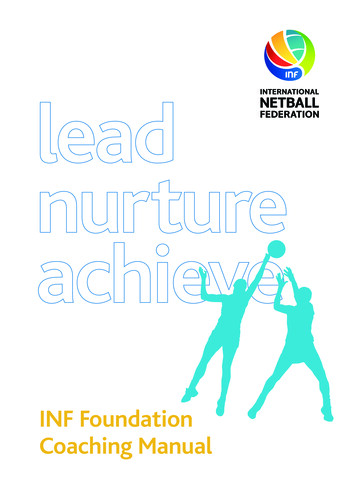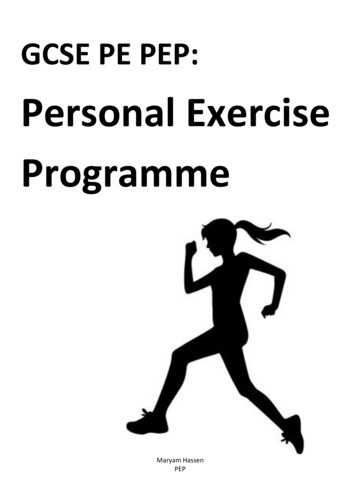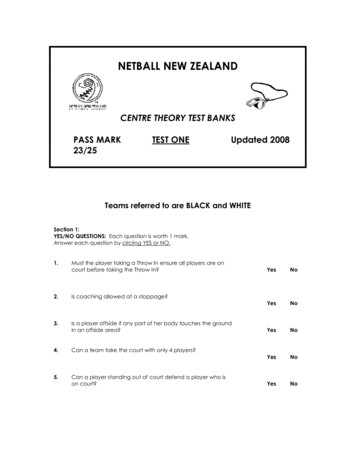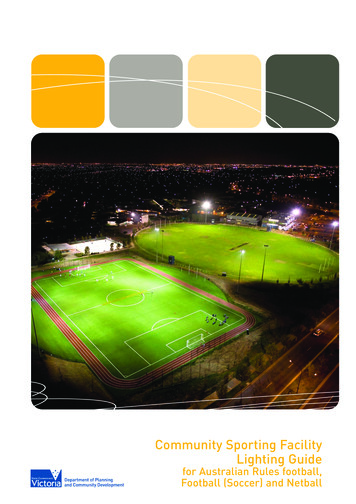
Transcription
leadnurtureachieveINF FoundationCoaching Manual
INF ForewordUrvasi Naidoo – Chief Executive OfficerThis coaching resource has been developed by the International Netball Federation (INF) in furtherance ofits mission to build a platform from which all INF Members can develop the sport and promote its corevalues. The INF recognises that good coaching is a key component in achieving that mission and therefore,one of its strategies is to support and develop quality coaching across its entire Membership.The manual focuses on the essential coaching skills that provide the foundation to the sport and will assistMembers with the successful delivery of coaching programmes around the world. The INF wish you all thevery best with your coaching work and with growing the great sport of netball in your country.The INF warmly thanks Jill McIntosh, Liz Broomhead, Norma Plummer and Yvonne Willering for their valuablesuggestions and contributions to the manual; former INF Global Development Manager, Sally Jarvis, forcompleting the project to a high standard and John Neate, Access Advertising, Manchester, for design andgraphics assistance and his tireless support.Copyright 2008 & 2012INF, Albion Wharf, 19 Albion Street, Manchester. M1 5LN
ContentsIntroductionThe Role Of The CoachCommunicationRole Of The ParentBalance & LandingCatchingPassing SkillsCatching & Passing On The MoveCatching, Throwing & Moving When Under PressureMovement & AgilityChanging DirectionAttacking SkillsDefending SkillsDefensive DrillsShootingCentre Pass StrategiesBack Line Throw-In StrategiesSkill AnalysisInstruction & FeedbackMatch Analysis & StrategiesStatisticsPlanningPlanning a Seasonal Training ProgramConducting A Training SessionCoaches Assessment SheetRecovery TechniquesOvercoming InjuriesThe Rules of NetballCoaches Code Of 21212122222324283233343636
IntroductionThe Importance of Teaching Foundation SkillsIt also takes good coaching. This is where the coach can makea difference.Netball is a wonderful game that gives us all a great deal ofsatisfaction and pleasure. It is a simple game, players throw, theycatch and they move. Sometimes as coaches we tend to make it toocomplicated. So much so that we end up tricking ourselves.Coaches have a responsibility to the players to have a very goodunderstanding of the foundation skills of netball. They must beable to teach and develop these skills in every player in a fun andenjoyable manner.Netball is about doing the simple things well, over and over again,every time. At the end of the match it is the team who makes theleast amount of unforced errors who will succeed. Champions arejust that because they make fewer errors than their opponents do.They are more consistent in everything they do. They have the abilityto consistently play with minimal errors in their game.Coaches should always be on the look out for players who cannotperform the foundation skills to the required level. Constantly lookingfor faults and supporting players to correct them is an on-going partof the role as a coach.It is the mastery of the foundation skills that underpins allachievements. So take the time to consider – “Why is it that someplayers can do it well whilst others cannot?” Those who achieve doso because they are prepared to put in the time and commitment tobeing the very best they can be.This guide will outline the foundation skills of Netball and the relevantcoaching points for each skill. If a young player can master theseskills, their individual flair and creativity will come to the top. It islike building a house. You need strong foundations on which to buildotherwise it will crumble and fall.The Role of the Coachyou are the teacher who will provide by far the most influence intheir sporting lives. The powerful influence should be a sacred trustfor all those who are in the position to help mould the character ofyoung people in their growing years. The Safeguarding andwelfare of your charges should be of primary concern.People start coaching for a number of reasons: Have been thinking about coaching a team for a while A Mum or Dad who wants to help out Would like to give back to the sport Have the experience and want to learn moreCoaches are people who instruct players in the execution of specificskills. When there is a discrepancy between what is required and whatis actually performed then the coach must know:about effective coachingAs a coach it is essential to be aware of: Why you are coaching – for every right reason Who you are coaching – age, level, ability, development How to coach – how will the activities be delivered to maximise What went wrong Why it went wrong How to correct the mistakeparticipation, learning, enjoyment, success, decision makingTherefore coaches tasks are those of observation, analysis andcorrection. There are two distinct roles played by the coach and theplayer. The coach sees a movement and is responsible for the correcttechnical execution of the skill. The player feels when the movementis correct. It is when a movement both looks and feels good thatthere is a successful partnership between coach and player. What to coach – skill and tactical requirements appropriate tothe needs and ability of the playersWhat is a coach?A coach is nstructorPublic relations personCoaching technique is largely an individual and personal skill thatis acquired, enhanced and modified in the light of experienceand experiment.Coaching is a constant challenge to:As you can see a coach wears many different and varied hats. Whenyou take on a coaching role you have a series of responsibilities thatthe players expect of you. Get the best performance out of the players at the right time Keep the players interested and motivated Be consistent and enthusiastic in your approach Be patient Out-think the opposition coachAs a coach you are a leader not merely a person with authority. Nextto their parents youngsters spend more time with, and are more likelyto be influenced by their teachers than anyone else. As the coach1
Now ask yourself why are you coaching? The word “enjoyment” mustbe in your answer somewhere. If you really don’t want to be there andit is becoming a burden to you maybe it is time for a break. Take aseason off, refresh yourself and renew your enthusiasm.What are the characteristics of a good coach? Must possess a sound technical knowledge of the foundationNetball skills and the rules governing the game Must have an awareness of the basic strategies,game tactics, routines and practices to complementthat sound technical knowledgeMost coaches expect too much, too soon from their players andbecome frustrated when everything doesn’t go as planned. Havepatience, begin with the basics and the rest will develop. Even coachesat the top levels make sure the basics of the game are performed withconsistent accuracy. Have clear and firm speech to obtain and hold attention Be a good listener Be flexible and adaptable to change when it is required Needs a sense of responsibility, good personal organisationSo have you checked the players footwork lately? Which foot do theyland on? Is it correct? Have a look. What about their throwing andcatching? Where are their hands positioned when they take the ball?How do they run? What are their arms doing when they sprint?and the administrative ability to effectively and reliablyimplement their coaching programsOther attributes of a good coach include:Coaching is a constant fault detection and correction process. Don’tforget to constantly check the so called ‘minor’ aspects such ascatching, throwing and footwork. Netball is based around running tocatch a ball then disposing of it in the best possible manner. Too oftencoaches are so intent on making drills as intricate as possible theyforget to check the minor aspects which, if left unattended, willdevelop into major deficiencies. A genuine passion for Netball and the players under thecoach’s control A consideration of the players needs and feelings Careful judgement when making decisions Take into consideration all matters from a common senseview point Being able to keep emotions under control The ability to think clearly at all times The need for sincerity and honesty in every phase of the program Not expecting too much too soon. A lack of patience is possiblyAsk yourself, why I am giving the players this activity? What is thepurpose of the activity? If it is only to keep them occupied and to takeup time in the session then think again. The activity must address afault that has been detected in match play or elsewhere. You must tryto assist every player to correct faults by devising an appropriateactivity. Watch the players in action. Isolate one or two players andplot their footwork and movement patterns and so on. The bestactivities come from these simple beginnings. Keep at it and enjoy theexperience. Rewards will come when you see the players perform tothe best of their ability every time.the greatest fault of the beginner coach Making every effort to give all players a fair and equal chance Being clean and neat in appearance Learning to speak clearly to obtain and hold attention Making sure body language is non-threatening to the players Being a harmonious co-worker with the people associatedHave you thought about your coaching philosophy? What is it?with netball Increase players enjoyment of Netball Improve players skill level & knowledge Give something back to the sport Improve players self esteem To share your knowledge Help the players to be the best they can be Having a sense of responsibility - players must know that theycan depend upon their coach at all timesAlthough the above attributes may not be all-inclusive they dorepresent those qualities in coaches that are most desirable and providea good guide for the personality and development of the coach. Youmust also understand the expectations you have of the job and whatplayers should reasonably be able to expect from you as a coach.Why do players play? Enjoyment Fun Friends Learn new skills Social SuccessYour ability as coach to improve performance depends to a large degreeon the ability to communicate. Not only verbally, but when listeningand using non-verbal communication such as body language e.g.grinning, sighing and shrugging.The major struggle for people entering coaching is to overcomethe stereotype that society has on what a coach should be like. Thestruggle to find ones own identity in coaching is very real. The profoundyet simple truth involved in coaching is to learn to be yourself. Don’ttry to be someone you are not. Work hard, be yourself and make thegame fun. Netball is a great game so enjoy it. Work within theframework of the rules and make Netball grow in a direction you canbe proud of in years to come. Improve skill level Development Sense of unity Sense of belonging Achieving goalsAll coaches are individual and therefore will do things differently.Basically coaches can be slotted into any of the categories orcombinations of those listed on the next page.2
AThe strong unwavering type who insists on maximum effort fromeveryone all the time. They always give their best and expectthe same in return. They are sympathetic towards the playersproblems but if anyone tries to cut corners they will be sorry.These coaches are able to assess a player’s potential and abilityquickly and accurately.DCreative and persuasive thinkers who prefer the gentle approach.They deal with players on an individual basis and are masters atgetting the best out of them. Before a competition they givethe players detailed instructions on how to execute theirmovements correctly as well as useful advice about theiropposition.BThe very thoughtful coach whose greatest fault is that they aretoo nice to everyone. They were classic performers themselves,proficient in all skills but slow to change to the moderntechniques and the changing patterns of Netball.EThe annoying coach. They get under the players skin. They arefeared and hated but above all are respected. Although they donot like being hated they believe it is the only way to be asuccessful coach.CThose coaches who hate to lose and their fiery temperamentsupsets their judgement at times. They have the ability to gatherideas from all sources, analyse the good from the bad and applythem effectively. They create tremendous drive which is transmittedto the players but they can also relax and mix with them.FThose coaches who upset the club with their tough attitudes todiscipline when they first take over but prove to be extremelyastute and very fair.CommunicationThe coach needs to develop the ability to listen well. Active listeningskills require a genuine interest in what is being said. To listen withgenuine interest the coach needs to:Communication can often be too much, too little or too late. Goodcommunication can be stimulating whilst bad communication can bevery boring. The coach aims to achieve good communicationbetween the athlete and the coach during the training session. Listen attentively – making and maintaining eye contact Allow the player time to talk without butting in Use non-verbal gestures to show that you are following what isCommunicating effectively is the coach’s responsibility andthey must manage this both when sending and receiving messages.This process takes place during informal conversations,group interaction sessions, whilst speaking in public or inwritten correspondence.being said (e.g. nodding) Use verbal gestures to show understanding and to encouragethe player (e.g. yes, I see)Communication can fail because of an unclear message or the senderusing complicated words or perhaps unfamiliar technical terms.Sometimes there is too much noise. Use questions to check information and encourage the playerCoaches can improve or make communication better by keeping themessage succinct and to the point and by being specific with themessage and using simple language. They must be prepared to clarifyif the message is not clear and repeat the message in different waysby using visual means or demonstrations.more description (e.g. so you don’t like to do push ups .)to open up (e.g. are you saying that . ?) Restating the information exactly as that given to encourage Talk only when necessary and when you do give anappropriate responseRemember active listening is a technique that helps the coachgather more information. Coaches can’t be listening if they are doingall the talking!Coaches need to assess the volume and tone of their voiceand can vary the pace of their speech whilst avoiding usingcomplicated words.Role of the Parentto stay involved. Children should be taught that the skills of the gameare vital as is an honest effort so that the result of each game isaccepted. Parents should never ridicule or yell at their child formaking a mistake or losing a competition. They should support allefforts to remove verbal and physical abuse from children’s sportingactivities. Children learn best by example so encourage by applaudinggood play.At home is where a child learns to be a “good sport”. By the time achild joins a team, a sense of sportsmanship (or lack thereof) isalready well established. Parents should not force an unwilling childto participate in sport. Children should play sport because they enjoyit. Children should always be encouraged to play by the rules andnot publicly question the officials judgement and never their honesty.They should have a positive attitude to their sport so that they want3
Balance & LandingHow do players stay upright? Using body strength and the correctlanding techniques assists the player to stay standing and notfall over. Knees should be in line with feet Knees should not be in front of feetLet’s look at the One Foot Landing Shoulders should be level Equal distribution of weight Head and eyes up Land ‘softly’ in sequence –(indicates weight too far forward)When players are on the move and catch the ball most often they willland on one foot first before grounding the other. Players shouldpractice landing in a balanced position so they are ready to pass. Itdoes not matter if they land on the left foot first or the right footfirst or with two feet simultaneously.toes, heels, bend knees and lower the centre of gravity Maintain control of the body When landing with two feet simultaneously spread the bodyCoaching Points Land with feet approximately shoulder width apart to give aweight evenly over both feetfirm support baseStability and strength are a vital foundation for being able to developthe necessary physical skills to play netball. Good landing techniquewill minimise the risk of injury. It allows the player to gain balancequickly before passing. When landing with one foot first quickly bring the other footdown to evenly spread the body weight over two feet Body should be upright when landing Bend knees, hips and ankles slightly on impact. This will helpcushion the force of the landingCatchingDo you actually look at the way your players catch the ball – everytime they catch? If they consistently drop the ball do you questionwhy? Or do you simply just say “pull it in”, “two hands” or “strongfingers”. Could there be an underlying reason why a playerconsistently drops the ball? E.g. eyes not watching the ball into thefingers but looking for the next pass.Coaching Points Emphasise a two handed catch over a one handed catch Eyes watching the ball into the hands Fingers and thumbs spread in a “W” shape ready to receive Fingers and thumbs relaxed but strong Hands and arms outstretched towards the ball Step forward and reach with hands to catch Snatch the ball with strong fingers and bend arms whenAs you watch the player keep asking yourself: What is it you are looking for? What are the fingers doing? Where are the fingers placed on the ball? What are the arms doing? Where are the arms placed when receiving the ball? What are the eyes looking at?receiving the ball to lessen the impact whilst pulling theball towards the body Keep thumbs behind the ball with fingers spread and relaxed Bring the ball back to the chest ready for the return pass Allow time for a balanced landing position before throwingthe ballPassing SkillsNetball is a game made up of a variety of passing techniques. Theplayer’s ability to pass accurate and well timed throws will determinethe success of the team. Players need to master the basic skills ofeach of the throwing techniques as well as balance, timing andcontrol. The player must learn when and where to pass the ball andwhich pass to use. The ball can be held with two hands but as the arm is takenback behind the shoulder the ball is held with one hand Elbow should be bent The opposite foot to the throwing arm should be forward Transfer the body weight from the back foot to the front footas the player steps forward with the front footCoaching Points The ball is pushed forward with the shoulder, elbow,Shoulder Pass – 1 handed Stand side-on to the intended receiverwrist and fingers Follow through with the hand whilst the fingers should be Feet should be shoulder width apart with knees slightly bentpointing in line with the throwand weight on the back foot4
Shoulder Pass – 2 handedLob Pass One or two handed pass The body can be facing or side-on to the receiver The ball should be released above the head As the throw is executed the throwing arm or arms moves upEverything is the same as the one handed shoulder pass but as thearm is taken back behind the shoulder two hands remain on the ball.Chest Pass Two hands behind the ball with thumbs and fingersand forward towards the receiverin a “W” shape The wrist and fingers direct the ball in a high arc into the space Ball held close to chest Elbows bent and relaxed by side Wrist and fingers direct and control the ball Step forward into the pass Weight is transferred onto the front foot Follow through with arms and fingers in the directionahead of the receiver The highest point of the arc should be when the ball passesover the defender Weight is transferred from the back to the front foot as thestep forward is madeIf players can throw these four passes with accuracy they willhave a very sound grounding for more advanced passes as theirNetball skills develop.of the pass As the player steps forward ensure feet are ina balanced positionSomething as basic as the throwing technique and variety ofpasses should not be a problem for players to master. Howeverdeciding which pass to use and when to use it can really be difficultfor some players.Bounce Pass A bounce pass can be performed with one or two handsfrom in front or the side of the body Hold the ball the same as for a shoulder pass Ball can be held at either waist or hip level Bend knees and step forward onto the front foot As the ball is pushed forward the hand and fingers shouldFactors that determine what pass a player should use and when theyshould release it: Positioning of attacker and defender Length of pass Positioning of immediate defender at 0.9m Timing of attacker’s movementfollow the path of the ball When executing the bounce pass the ball shouldbounce approximately 2/3’s of the distance betweenpasser and receiverPlacement of the pass into a space can be hard for some players torecognise. Keep re-affirming the placement of each pass into thecorrect space by pointing out where the defender is positioned andthrowing the ball into the space away from the defender.Catching & Passing on the MoveOnce players master the ability to catch and throw in the stationaryposition the next progression is to do it whilst on the move. Playersneed to be able to put it all together when on the move.Considerations include: Balance on the landing Being in control of the body Applying the same catching and throwing techniquesas when in the stationary position The ability to make quick decisionsThese areas may seem basic but they are very important because inthe end if players can’t catch, throw and move what good is anythingelse? Remember Netball is about doing the basics consistently wellover and over, every time.5
Catching, Throwing & MovingWhen Under PressureThe player’s ability to remain calm and in control when underpressure is extremely important as they attempt to execute the skills.Remember balance and control comes before speed.Players should be able to catch, throw and move when not pressured.Players also should be able to perform these skills when underextreme pressure. Pressure can be applied to players in many ways: Reducing or increasing the amount of space in which theplayers can move By adding defenders to any activity Putting a time-frame on the activity Placing players against one another in acompetitive environmentMovement & AgilityThe ability to run, jump and change direction are major componentsof Netball. Not all players can run and move freely. They find itdifficult to get their feet moving quickly or in the right direction. Asa coach you need to consider how do players get to where they wantto go? Sometimes they walk, sometimes jog or run and finally sprint.Some may need to change the direction of their movement. Theyalso need to be able to stop. These are the movement skills of Netballand frequent practice will develop the ability of players to executethem successfully.Generally natural body movements dictate whether an outward orinward rotation is executed. Usually at the basic levels an outwardrotation (away from the defender) is encouraged. As the playerdevelops and their body control improves they also learn to turninward on the pivot. The placement of the ball also dictates whetherthe player will execute an outward or inward pivot. It is important torecover after catching or intercepting the ball to allow time to landsafety, balance, pivot, see and make a decision before passing the ball.Choosing the right moves to get free of their opponent at the righttime can be difficult. So when planning your training make sureyou include some of these movements:Dodging is a short, sharp movement often executed from a stationarybeginning. It can be used to quickly change direction to create spacefor themselves or team mates. It also allows the attacker to wrongfoot or take the defending player away from the space where the ballis to be caught.Dodging Change of Pace e.g. walking, jogging, running & sprinting Pivoting/turning Changing of Direction Stopping Begin with a comfortable stance Feet shoulder width apart Weight evenly distributed Knees and hips bent slightly Body should be upright with head and eyes up watchingMany coaches think speed is the essence of a good attacker. Speedoff the mark is important but speed must be accompanied by balanceand control. Also along with speed is the ability to time themovement correctly.the play Arms are bent so that elbows are in a relaxed positionby the sideAs coaches you must look at when a player begins their movement.When do they change direction? How does a player know whetherto move in a straight direction or change that direction? The abilityof the player to read the game will assist in the timing of themovement. Take 1 or 2 short, quick steps in the opposite direction to whereyou want to catch Ground the outside foot Knee bends as the centre of gravity is lowered Pivot on the ball of your grounded foot and rotate it, knees andPivotinghips in the desired direction then push offThis movement is necessary when the player receiving the ball wishesto turn ready to pass. In order to pivot the player with the ball mustturn in a rotating motion on the ball of the first grounded foot. Thisturning motion should be away from the defender. The ball shouldbe held close to the body whilst it is positioned to throw. As theplayer pivots around, the head should precede the body so the eyesare looking at where the pass can be thrown. Weight is quickly transferred back over the inside foot as theplayer accelerates in the new direction Arms pump to enhance accelerationAll movements when dodging must be quick and decisive. Goodbalance should be maintained throughout the movement. Correctfootwork and quick decision making assist to execute this skill.6
Changing DirectionCoaches should look to devise activities that simulate the above skillsmaking sure they also have a change of speed in the activities.The change of direction is executed from a longer run. The sametechnique is used as for the dodge but the player changes directionafter making a longer run.Attacking SkillsYour team is in attack when they have possession of the ball. Allseven players on court must develop appropriate attacking skills tocompetently bring the ball down through the court to the shooters.Effective attacking play comes from the player’s ability to catch andthrow whilst moving combined with changes of speed and timing ofmovement. Good attackers also find the right spaces in which tomove. By using various methods to get free the attacking player aimsto lose their immediate opponent before catching and passing. Thisvariety in movements creates patterns of play. Explosive speed,agility, strength and endurance are necessary components of a goodattacking player.Qualities of a Good Attacking g speedAssertiveElevationPatientEnduranceCool exteriorStrengthInner calmnessPowerTemperamentBalanceDecision makerDefending AbilityCreativeAgilityInitiatorFlexibilityClear thinkerVisionReads the play wellFootworkSelf controlQuick reflexesStrength of mindAwareness/Reaction timePersistenceGood communicatorDesire to achieveShort recovery timeConcentrationBody Language – relaxed under pressureAble to take controlAbility to work in small spacesGoal setting abilityVariety of movementMental rehearsalVariety of passVisualisation/imagerNon-verbal cues - Body Language – confidenceIn order to achieve this players must: Have accurate and consistent catching and passing skills Have good vision Have an awareness of how to create space Have the ability to use a variety of methods of getting free The capacity to select and instigate appropriate timing ofthe movement with changes of pace Ensure balance and control at all timesA good attacking player needs to be able to executethe following movements: Straight and Diagonal leads Dodge Change of Direction Change of PaceAttackers can become mentally pressured when they are ill preparedor agitated. They can be easily distracted and lose focus then panicsets in. Illogical thoughts start to enter into their decision makingprocess which slows their reaction time. At this time self doubts startto creep in and the attacker is often in two minds about things.Consequently their confidence drops and they become very criticalof themselves and their team mates. Their error rate increases whichwastes energy as their emotions rage out of control.They must have good balance, be decisive in their movements as wellas have strength and power.They need good spatial awareness in relation to themselves, the ball,their team mates and the opposition. They must also have thecapacity to use the information gained to make quick decisions, havegood communication both verbal and non-verbal and be able to readthe cues of their team mates and the opposition.Before moving the attacking player must take into consideration: The spaces that are available Their starting position in relation to the defender and theirCoaches can enhance the player’s abilities by providing practices thatshow progression and have court relevance.team mates The timing of the movement Any limitations of space that may require a preliminarymovement to create space7
TimingStraight leadThe timing of any movement can be thrown off by pressure, stre
the stereotype that society has on what a coach should be like. The struggle to find ones own identity in coaching is very real. The profound yet simple truth involved in coaching is to learn to be yourself. Don’t try to be someone you are not. Work hard, be yourself and make the game










